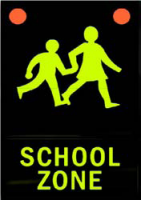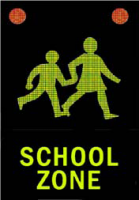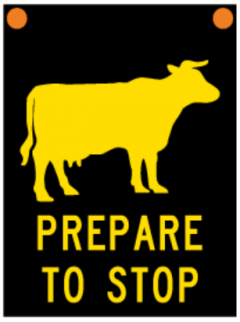Refer also to the Speed management guide
Active – flashing light (with reflective symbol and text)
(minimum size as specified for sign W19-2.2 symbolic warning - active flashing light (with symbol W16-4 Children))
|
Shape and size |
Rectangle 700 x 900mm |
|
Background |
Black |
|
Symbol |
Children – 600mm wide x 480mm high retroreflective, fluorescent yellow-green |
|
Text |
‘SCHOOL ZONE’ 100mm high/14mm stroke width retroreflective, fluorescent yellow-green |
Note: The larger size of sign (900mm wide x 1200mm high) can be used in 50km/h areas if considered appropriate. Larger sizes may be used, particularly where the speed limit is above 50km/h or there is a wide or divided carriageway.
Appendix Figure 4:
Active – flashing light

Active – LED (light emitting diodes)
(minimum size as specified for sign W19-2.1 symbolic warning - Active – LED (with symbol W16-4 Children))
|
Shape and size |
Rectangle 700mm wide x 1000mm high |
|
Background |
Black |
|
Symbol |
W16-4 Children – 600mm wide x 480mm high yellow LED |
|
Text |
SCHOOL ZONE yellow LED, letters 160mm high / 25mm stroke width |
Note: Larger sizes may be used, particularly where the speed limit is above 50km/h or there is a wide or divided carriageway.
Appendix Figure 5:
Active - LED

The lights should:
There may be a need to have an indicator light that can be seen from the rear of the sign from the school or crossing point to indicate when the lights are operating.
Options to be considered for supplying power to the active sign units include:
Signs can be attached to power poles so the units have a solid base. Where new support structures have to be erected they should be at least 100mm diameter with a foundation design that will prevent twisting yet remain frangible. They should be mounted high enough to provide a suitable clearance above the footpath or ground so they are less likely to be tampered with. The recommended clearance above footpaths it 2.5m. However, if the support pole is located close to the kerb where large vehicles (such as buses) are likely to stop, then a higher mounting height of 4.4m or more may be needed so that the sign is not damaged by high vehicles.
Signs should be placed so the driver’s view of them is not obscured by vegetation. If necessary, trees located near the roadway should be pruned regularly to maintain the effectiveness of these signs. At some sites where there is a special need to highlight the presence of the school to drivers, a duplicate active school zone warning sign can be placed on the right-hand side of the road or on a solid median.
There are different types of activation systems depending on the sign type and operation. These include:
The control box or activation unit should be located at a secure place within the school grounds where only authorised personnel can have access to it.
The programming system needs to allow for any variations to normal school operating hours including holidays and events that may be held at the school outside normal hours. The activation units need to be programmed to allow information to be entered into the system for set school activity times, holidays and daylight saving time changes together with a manual override system to allow for one-off special events.
The times when the signs operate should coincide with the school activity times as agreed in writing by the school and RCA. A time-out facility should be installed so that the signs automatically switch off after a maximum time (possibly 1 hour for normal use and possibly 30 minutes for one-off events) if the unit has not been manually switched off.
The programming system can be completed by installation of specific software. Further information should be obtained from the sign supplier.
It is essential that regular checks are made to ensure the active device is working correctly. The RCA needs to ensure that appropriate inspection and maintenance systems are in place as part of its agreement with those authorised to operate the system. The respective maintenance responsibilities of the RCA and the school should be clearly set out in this written agreement.
The general approach to the use of active warning signs is set out in the TCD manual Part 1 - General requirements for traffic signs, section 6.2. This reference should be consulted when considering the use and installation of active warning signs.
There are three options which can be considered. An active warning sign can:
Generally the following active components should only be displayed while the hazard exists on or near the roadway:
The RCA should ensure that active components are turned off when the hazard is not present. Additional detection devices may be needed to achieve this.
W19-1.1 General warning variable
|
Application |
|
|---|---|
|
Shape and size |
Rectangle sized to suit the message requirements |
|
Background |
Black |
|
Legend |
Such words as are necessary to convey the information to traffic in no more than 3 lines of text per screen and no more than 2 screens of text. If 2 screens are used the text must alternate between the 2 and not scroll between them. |
|
Application |
|
|---|---|
|
Colour |
Yellow or white LED |
|
Text |
Letters 200mm high / 31mm stroke width |
W19-2.1 Symbolic warning - active LED
|
Application |
|
|---|---|
|
Shape and size |
Rectangle 700mm wide x 1000mm high |
|
Background |
Black |
|
Symbol |
As appropriate – 600mm wide x 480mm high |
|
Colour |
Yellow LED |
|
Text |
As specified for selected symbol. Yellow LED, letters 160mm high / 25mm stroke width |
Note: 700 x 1000mm is the minimum size as specified in the TCD Rule. Larger sizes may be used, particularly where the speed limit is above 50km/h or there is a wide or divided carriageway.
W19-2.2 Symbolic warning - active flashing light
|
Application |
|
|---|---|
|
Shape and size |
Rectangle 700 x 900mm |
|
Background |
Black |
|
Symbol |
600mm wide x 480mm high |
|
Other features |
Two orange flashing lights located at the top of the sign |
|
Colour |
As specified for selected symbol. Retroreflective yellow, or retroreflective fluorescent yellow-green. |
Appendix Figure 6: Active flashing light

Note: 700 x 900mm is the minimum size as specified in the TCD Rule. Larger sizes may be used, particularly where the speed limit is above 50km/h or there is a wide or divided carriageway.
If installed in the sign, the lights should:
Options to be considered for supplying power to the active sign units include:
Permanent signs can be attached to power poles so the units have a solid base. Where new support structures have to be erected, they should be at least 100mm diameter with a foundation design that will prevent twisting yet remain frangible. Refer to Specification P24: permanent traffic signs.
Specification P24: permanent traffic signs.
They should be mounted high enough to provide a suitable clearance above the footpath or ground so they are less likely to be tampered with (particularly in urban areas). A clearance of 2.5m above footpaths is recommended. However, if the support pole is located close to the kerb where large vehicles (such as buses) are likely to stop, then a higher mounting height of 4.4m or more may be needed so that the sign is not damaged by high vehicles.
Signs should be placed so the driver’s view of them is not obscured by vegetation. If necessary, trees located near the roadway should be pruned regularly to maintain the effectiveness of these signs.